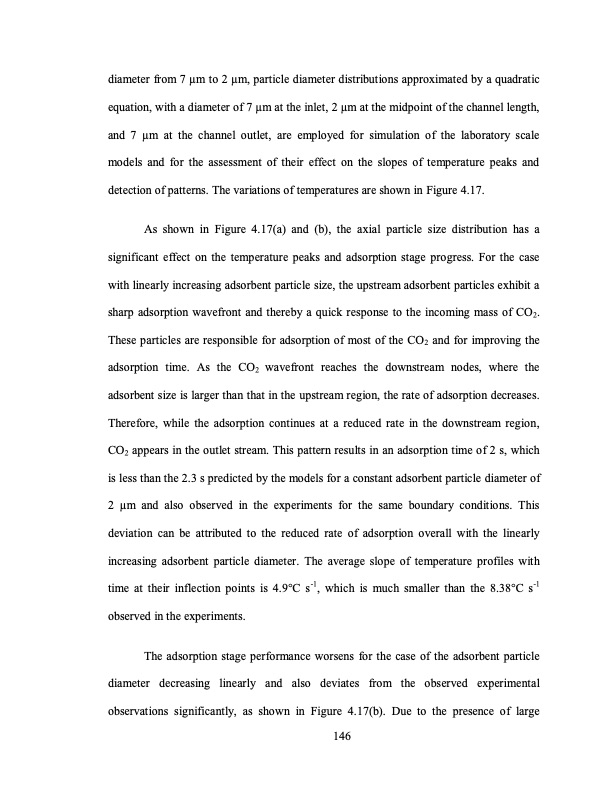
PDF Publication Title:
Text from PDF Page: 173
diameter from 7 μm to 2 μm, particle diameter distributions approximated by a quadratic equation, with a diameter of 7 μm at the inlet, 2 μm at the midpoint of the channel length, and 7 μm at the channel outlet, are employed for simulation of the laboratory scale models and for the assessment of their effect on the slopes of temperature peaks and detection of patterns. The variations of temperatures are shown in Figure 4.17. As shown in Figure 4.17(a) and (b), the axial particle size distribution has a significant effect on the temperature peaks and adsorption stage progress. For the case with linearly increasing adsorbent particle size, the upstream adsorbent particles exhibit a sharp adsorption wavefront and thereby a quick response to the incoming mass of CO2. These particles are responsible for adsorption of most of the CO2 and for improving the adsorption time. As the CO2 wavefront reaches the downstream nodes, where the adsorbent size is larger than that in the upstream region, the rate of adsorption decreases. Therefore, while the adsorption continues at a reduced rate in the downstream region, CO2 appears in the outlet stream. This pattern results in an adsorption time of 2 s, which is less than the 2.3 s predicted by the models for a constant adsorbent particle diameter of 2 μm and also observed in the experiments for the same boundary conditions. This deviation can be attributed to the reduced rate of adsorption overall with the linearly increasing adsorbent particle diameter. The average slope of temperature profiles with time at their inflection points is 4.9°C s-1, which is much smaller than the 8.38°C s-1 observed in the experiments. The adsorption stage performance worsens for the case of the adsorbent particle diameter decreasing linearly and also deviates from the observed experimental observations significantly, as shown in Figure 4.17(b). Due to the presence of large 146PDF Image | TEMPERATURE SWING ADSORPTION PROCESSES FOR GAS SEPARATION

PDF Search Title:
TEMPERATURE SWING ADSORPTION PROCESSES FOR GAS SEPARATIONOriginal File Name Searched:
PAHINKAR-DISSERTATION-2016.pdfDIY PDF Search: Google It | Yahoo | Bing
CO2 Organic Rankine Cycle Experimenter Platform The supercritical CO2 phase change system is both a heat pump and organic rankine cycle which can be used for those purposes and as a supercritical extractor for advanced subcritical and supercritical extraction technology. Uses include producing nanoparticles, precious metal CO2 extraction, lithium battery recycling, and other applications... More Info
Heat Pumps CO2 ORC Heat Pump System Platform More Info
| CONTACT TEL: 608-238-6001 Email: greg@infinityturbine.com | RSS | AMP |